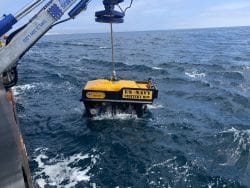The U.S. Space Force spoke out Wednesday to condemn Russia for testing a new ground-launched anti-satellite missile it says are “contrary to Russia’s diplomatic and public stance against the weaponization of space.” The newest U.S. military branch also warned of other weapons Russia is developing for space, including an on-orbit space weapon and a ground-based laser system developed for use by Russia’s space forces.
In an emailed statement to American Military News, the Space Force said, “The United States is concerned by Russia’s continued development and deployment of several types of ground-based and space-based ASAT (anti-satellite) weapons. These actions are contrary to Russia’s diplomatic and public stance against the weaponization of space.”
The Space Force said Russia has already demonstrated two different types of space weapons.
“The first type of kinetic weapon is a [direct-ascent anti-satellite] DA-ASAT system capable of destroying satellites in low Earth orbit, which they have tested multiple times,” the Space Force said. “If this weapon is tested on an actual satellite or used operationally, it will cause a large debris field that could endanger commercial satellites and irrevocably pollute the space domain.”
The Space Force did not specify when Russia tested the DA-ASAT missile.
“The second type is a co-orbital ASAT, a space-based weapon system, which demonstrated an on-orbit kinetic weapon in 2017 and again in 2020,” the Space Force said.
The Space Force described previous DA-ASAT weapons tests by Russia and in an April statement. In the April statement, the Space Force also described a potential on-orbit weapon it observed in a February incident in which two Russian satellites, dubbed COSMOS 2542 and COSMOS 2543, “exhibited characteristics of a space weapon” by maneuvering near a U.S. satellite in a manner “that would be interpreted as irresponsible and potentially threatening in any other domain.”
In addition to the two kinetic space weapon types it described Wednesday, the Space Force said, “In March 2018, President Putin announced the development of a ground-based laser system for use by the Russian Space Forces, which the Russian military acknowledged as a ‘combat laser system.'”
“Russia publicly claims it is working to prevent the transformation of outer space into a battlefield, yet at the same time Moscow continues to weaponize space by developing and fielding on-orbit and ground-based capabilities that seek to exploit U.S. reliance on space-based systems,” U.S. Army Gen. James Dickinson said in comments accompanying the Space Force statement. “Russia’s persistent testing of these systems demonstrates threats to U.S. and allied space systems are rapidly advancing. The establishment of U.S. Space Command as the nation’s unified combatant command for space and U.S. Space Force as the primary branch of the U.S. Armed Forces that presents space combat and combat support capabilities to U.S. Space Command could not have been timelier. We stand ready and committed to deter aggression and defend our Nation and our allies from hostile acts in space.”
Dickinson continued, stating, “Russia has made space a warfighting domain by testing space-based and ground-based weapons intended to target and destroy satellites. This fact is inconsistent with Moscow’s public claims that Russia seeks to prevent conflict in space. Space is critical to all nations. It is a shared interest to create the conditions for a safe, stable, and operationally sustainable space environment. The demands on the space systems continue in this time of crisis where global logistics, transportation, and communications are key to defeating the COVID-19 pandemic.”
While Russia has reportedly tested two kinetic space weapons and a laser weapon that could be used for space purposes, the Space Force unveiled its own first offensive space weapon in March, in the form of a satellite jammer known as the Counter Communications Systems (CCS) Block 10.2.







